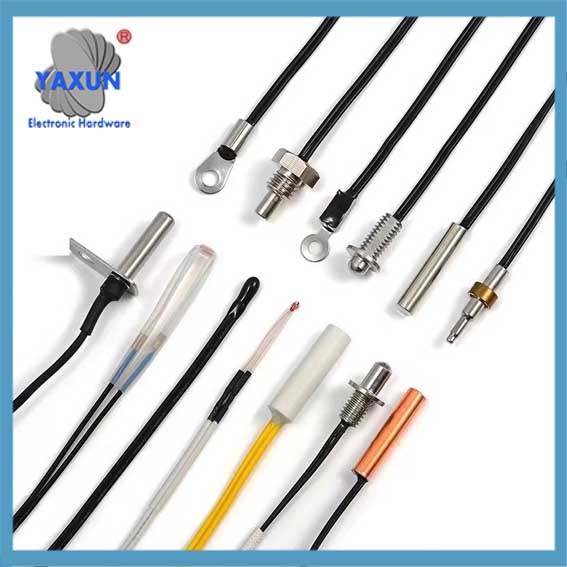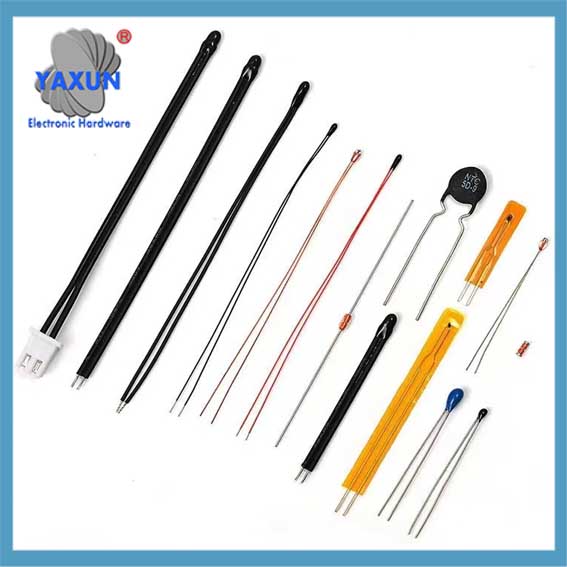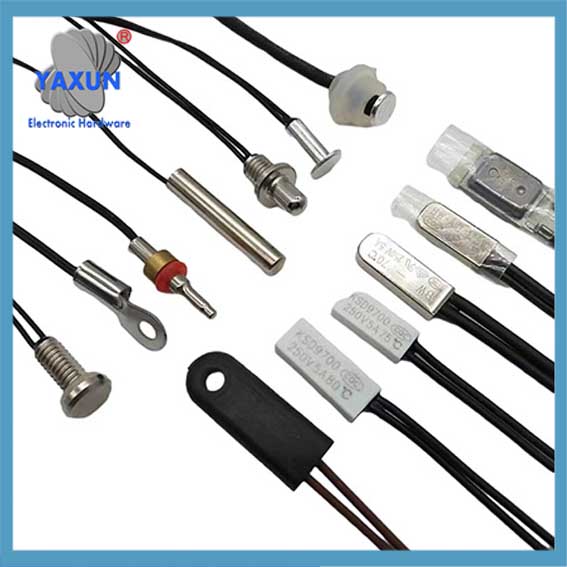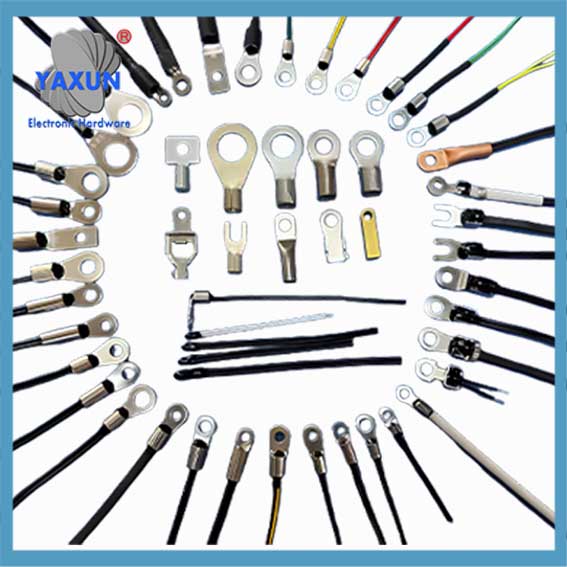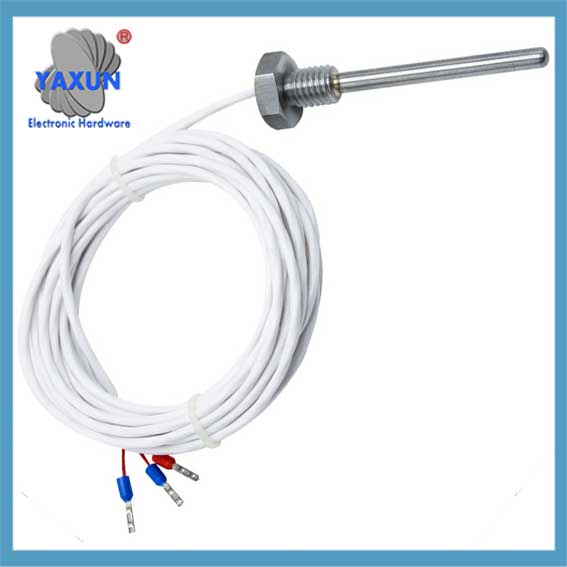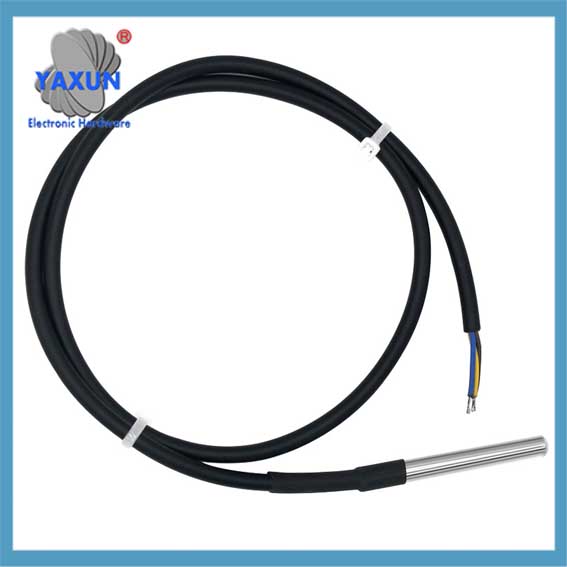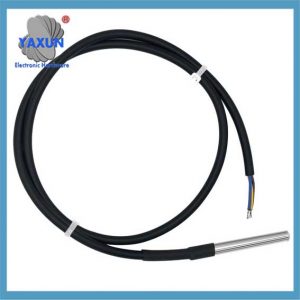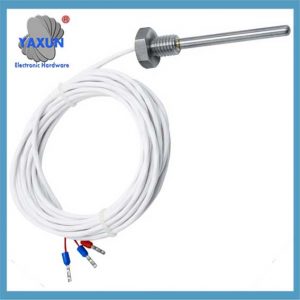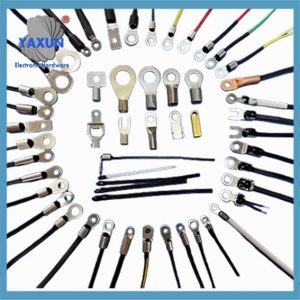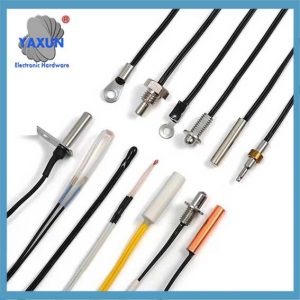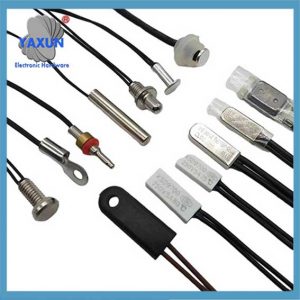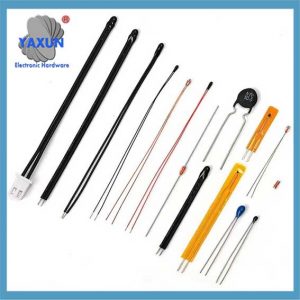Categorías de Producto
- fusible térmico 32
- fusibles de montaje en superficie 12
- termistor 36
- Portafusibles de montaje en PCB 27
- Arnés de cableado 6
- Portafusibles de cuchilla 17
- termostato 50
- Fusible eléctrico 24
- Sensor de temperatura automotriz 7
- Disyuntor térmico 22
- Portafusibles 36
- Sensor de temperatura 75
- Interruptor térmico 68
- Fusible del coche 20
- Fusibles atornillados 8
Etiquetas de productos
Sondas de temperatura, Tipos de sensores de temperatura & aplicaciones
Una sonda de temperatura es un dispositivo utilizado para medir la temperatura., Generalmente consta de un elemento sensible y un circuito de medición.. El elemento sensible puede ser un termopar. (pt100, pt1000), una resistencia térmica (ntc, ptc), un semiconductor (DS18B20 digitales), etc., que puede convertir los cambios de temperatura en señales eléctricas. Luego se amplifica, filtrado, convertido, y procesado por el circuito de medición, y finalmente se emite una señal eléctrica proporcional a la temperatura..
Las sondas de temperatura y los sensores de temperatura son dos dispositivos diferentes, y tienen sus propias características y escenarios de aplicación para medir la temperatura.
Sonda de temperatura
A “sonda de temperatura” es un sensor utilizado para medir la temperatura al convertir la energía térmica en una señal eléctrica medible, y los tipos más comunes de sensores de temperatura dentro de una sonda incluyen termopares, Detectores de temperatura de resistencia (RTD), y termistores, cada uno con características y aplicaciones distintas basadas en la precisión requerida, rango de temperatura, y tiempo de respuesta necesario para una situación específica.
definición: Una sonda de temperatura es un dispositivo utilizado para medir la temperatura., Generalmente consta de un elemento sensible y un circuito de medición.. El elemento sensible puede ser un termopar. (pt100, pt1000), una resistencia térmica (ntc, ptc), un semiconductor (DS18B20 digitales), etc., que puede convertir los cambios de temperatura en señales eléctricas. Luego se amplifica, filtrado, convertido, y procesado por el circuito de medición, y finalmente se emite una señal eléctrica proporcional a la temperatura..
Principio de trabajo: El principio de funcionamiento de la sonda de temperatura es utilizar la respuesta del elemento sensible a los cambios de temperatura para convertir los cambios de temperatura en señales eléctricas. Los elementos sensibles comunes incluyen termopares, resistencias térmicas, semiconductores, etc.. El principio de funcionamiento del termopar es usar el efecto termoeléctrico de dos metales o aleaciones diferentes.. Cuando están conectados juntos y a diferentes temperaturas, Se genera una fuerza electromotora proporcional a la temperatura. El principio de funcionamiento de la resistencia térmica es utilizar la propiedad que la resistencia de los materiales de metal o semiconductores cambia con la temperatura. Cuando la temperatura cambia, El valor de resistencia también cambiará en consecuencia. El principio de funcionamiento del semiconductor es utilizar la propiedad que la conductividad del material semiconductor cambia con la temperatura. Cuando la temperatura cambia, La conductividad también cambiará en consecuencia.
tipo: Los tipos de sondas de temperatura incluyen principalmente sondas de termopar, sondas de resistencia térmica, sondas de semiconductores, etc.. Las sondas de termopar usan termopares como elementos sensibles, y tener las características del amplio rango de medición, Velocidad de respuesta rápida, y alta precisión. Las sondas de resistencia térmica usan resistencias térmicas como elementos sensibles, y tener las características de alta precisión de medición, buena estabilidad, y fuerte capacidad anti-interferencia. Las sondas de semiconductores usan semiconductores como elementos sensibles, y tener las características del tamaño pequeño, peso ligero, y bajo consumo de energía.
Campos de aplicación: Las sondas de temperatura se usan ampliamente en la industria, investigación científica, atención médica, Protección del medio ambiente y otros campos. Tales como la medición y el control de la temperatura en químicos, petróleo, metalurgia, electricidad, farmacéutico, Alimentos y otras industrias.
Cable del sensor de temperatura DS18B20 con sonda
Alambrado: Rojo(VCC), Amarillo(Datos), Negro(Gnd)
Amplio rango de temperatura de -55 ℃ ~ +125 ℃
Fuente de alimentación: 3.0V ~ 5.5V
Consejos: El uso de una resistencia de 4.7k entre los datos y el VCC realizará la prueba de la sonda Easilier.
Par termoeléctrico:
Función: Genera una diferencia de voltaje basada en la temperatura en la unión de dos cables de metal diferentes.
Pros: Amplio rango de temperatura (-200° C a 1750 ° C), relativamente económico, Tiempo de respuesta rápido.
Contras: Menor precisión en comparación con otros sensores, requiere tablas de calibración para convertir el voltaje a la temperatura.
Aplicaciones: Aplicaciones de alta temperatura como hornos, monitoreo del motor, procesos industriales.
Termistor:
Aplicaciones de sondas de temperatura:
Procesos industriales: Monitoreo de la temperatura en procesos de fabricación como hornos, reactores, y extrusoras.
Sistemas HVAC: Regular la temperatura ambiente en los edificios al monitorear la temperatura del aire.
Seguridad alimentaria: Monitoreo de la temperatura de los alimentos durante la cocción y el almacenamiento para garantizar la seguridad de los alimentos.
Dispositivos médicos: Medir la temperatura corporal en pacientes a través de sondas insertadas en el cuerpo.
Industria automotriz: Monitoreo de la temperatura del refrigerante del motor y la temperatura de la cabina.
Investigación científica: Mediciones de temperatura precisas en experimentos.
Sensor de temperatura
definición: Un sensor de temperatura es un dispositivo que puede convertir los cambios de temperatura en señales eléctricas. Por lo general, consiste en un elemento sensible y un circuito de procesamiento de señal. El elemento sensible puede ser un termopar., resistencia térmica, semiconductor, etc.. El circuito de procesamiento de la señal puede ser un circuito analógico, un circuito digital, etc., que juntos completan la adquisición, Procesamiento y emisión de señales de temperatura..
Principio de trabajo: El principio de trabajo del sensor de temperatura es similar al de la sonda de temperatura. También utiliza la respuesta del elemento sensible al cambio de temperatura para convertir el cambio de temperatura en una señal eléctrica. Sin embargo, El sensor de temperatura generalmente tiene un circuito de procesamiento de señal más complejo, que puede realizar un procesamiento más avanzado en la señal de temperatura, como la conversión digital, almacenamiento de datos, comunicación, etc..
tipo: Los tipos de sensores de temperatura incluyen principalmente sensores de temperatura analógica, Sensores de temperatura digital, y sensores de temperatura inteligentes. Sensores de temperatura analógica Salida señales analógicas, que deben convertirse en señales digitales a través de convertidores analógicos a digitales. Los sensores de temperatura digital emiten directamente señales digitales, y tener las características de una fuerte capacidad anti-interferencia, alta precisión, e integración fácil. Los sensores de temperatura inteligentes tienen funciones como el autodiagnóstico, autocalibración, y comunicación, y puede realizar monitoreo y control remotos.
características: El sensor de temperatura tiene las características de la alta precisión de la medición, buena estabilidad, fuerte capacidad antiinterferencia, e integración fácil. Diferentes tipos de sensores de temperatura tienen diferentes características, como los sensores de temperatura analógica requieren convertidores analógicos a digitales, Los sensores de temperatura digital emiten directamente señales digitales, y los sensores de temperatura inteligentes tienen funciones como el autodiagnóstico, autocalibración, y comunicación.
Campos de aplicación: Los sensores de temperatura se usan ampliamente en el hogar inteligente, portátil inteligente, equipo medico, automatización industrial, monitoreo ambiental y otros campos, como aire acondicionado, refrigeradores, lavadoras, termómetros, esfigmomanómetros, sistemas de control industrial, etc..
Cómo elegir?
Al elegir una sonda de temperatura o un sensor de temperatura, Los siguientes factores deben considerarse:
Entorno de aplicación: Considere si el entorno medido tiene condiciones especiales como corrosividad., temperatura alta, presión alta, etc., para seleccionar materiales y niveles de protección adecuados.
Rango de medición: Seleccione un sensor adecuado de acuerdo con el rango de temperatura a medir para garantizar que el sensor pueda medir con precisión dentro del rango requerido.
Requisitos de aceptación: Seleccione un sensor con precisión correspondiente de acuerdo con los requisitos de precisión de la aplicación para la medición de la temperatura.
Presupuesto de cosecha: Seleccione un sensor rentable de acuerdo con las limitaciones presupuestarias.
Cómo usar?
Cuando se usa una sonda de temperatura o sensor de temperatura, Se deben tener en cuenta los siguientes asuntos:
instalación: Instálelo correctamente de acuerdo con las instrucciones de instalación del sensor para asegurarse de que el sensor esté en buen contacto con el objeto a medir y evitar errores de medición causados por una instalación incorrecta.
alambrado: Conecte correctamente la línea de señal y la línea de alimentación del sensor para garantizar la estabilidad y precisión de la transmisión de la señal..
calibración: Calibre el sensor periódicamente para garantizar que la precisión de su medición cumpla con los requisitos de la aplicación..
mantenimiento: Limpie y mantenga el sensor regularmente para evitar el polvo., suciedad, etc.. afectando el rendimiento de medición del sensor.
El sensor de sonda de temperatura es uno de los productos importantes de nuestra empresa YXAUN. Nos centramos en los campos de la fabricación inteligente y la automatización industrial, y proporcionar una serie de equipos de medición y control de alta precisión y de alta precisión, incluyendo sensores de sonda de temperatura. Nuestros sensores de sonda de temperatura se utilizan ampliamente en la fabricación industrial, monitoreo ambiental, Gestión de la energía y otras industrias con su alta precisión, estabilidad y adaptabilidad a entornos complejos. Si tiene necesidades o preguntas específicas sobre nuestros sensores de sonda de temperatura, No dude en consultarnos. Le proporcionaremos de todo corazón respuestas y servicios profesionales.. ¿Qué aspecto del sensor de sonda de temperatura quieres saber??
Cómo elegir un sensor de sonda de temperatura adecuado?
Al elegir un sensor de sonda de temperatura, Considere el rango de medición de temperatura, requisitos de precisión, Velocidad de respuesta e entorno de instalación. Por ejemplo, Se pueden seleccionar termopares o resistencia al platino para entornos industriales, PT100 para alta precisión, y termopares para una respuesta rápida.
Contáctenos
Esperando tu email, le responderemos dentro de 12 horas con la valiosa información que necesitabas.
 English
English Afrikaans
Afrikaans العربية
العربية বাংলা
বাংলা bosanski jezik
bosanski jezik Български
Български Català
Català 粤语
粤语 中文(简体)
中文(简体) 中文(漢字)
中文(漢字) Hrvatski
Hrvatski Čeština
Čeština Nederlands
Nederlands Eesti keel
Eesti keel Suomi
Suomi Français
Français Deutsch
Deutsch Ελληνικά
Ελληνικά हिन्दी; हिंदी
हिन्दी; हिंदी Magyar
Magyar Bahasa Indonesia
Bahasa Indonesia Italiano
Italiano 日本語
日本語 한국어
한국어 Latviešu valoda
Latviešu valoda Lietuvių kalba
Lietuvių kalba македонски јазик
македонски јазик Bahasa Melayu
Bahasa Melayu Norsk
Norsk پارسی
پارسی Polski
Polski Português
Português Română
Română Русский
Русский Cрпски језик
Cрпски језик Slovenčina
Slovenčina Slovenščina
Slovenščina Español
Español Svenska
Svenska ภาษาไทย
ภาษาไทย Türkçe
Türkçe Українська
Українська اردو
اردو Tiếng Việt
Tiếng Việt
